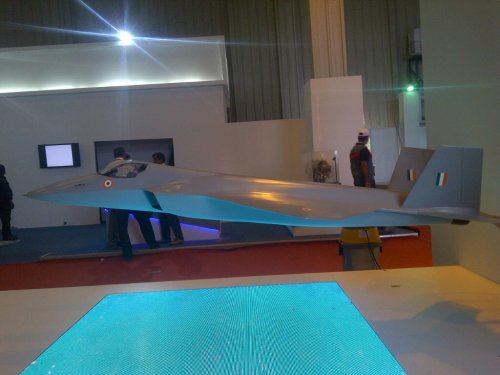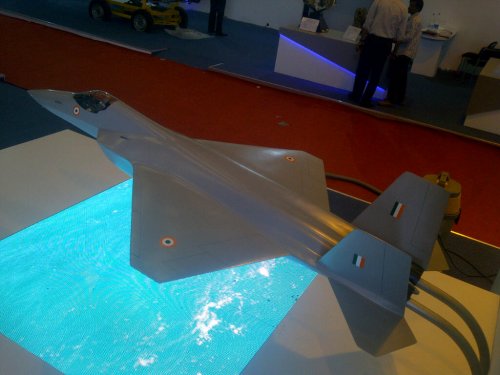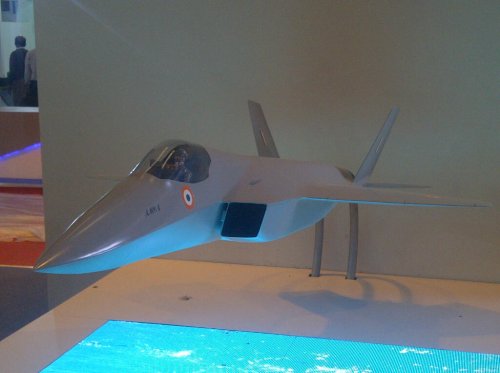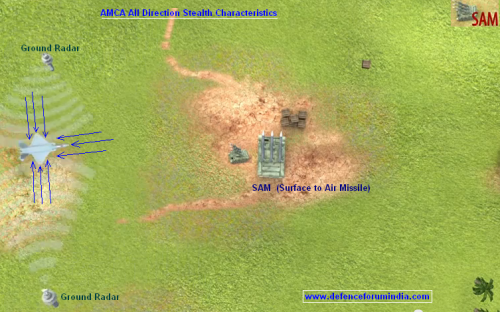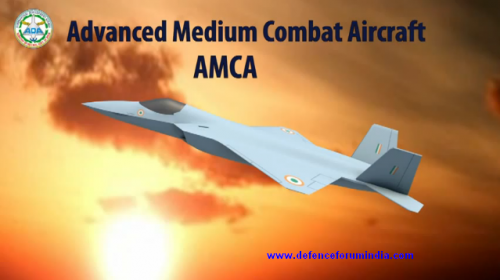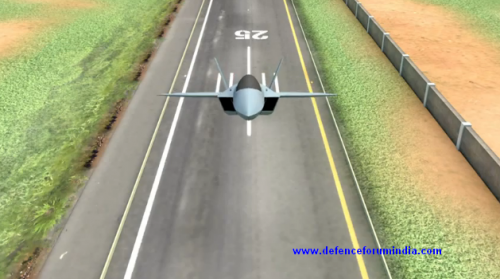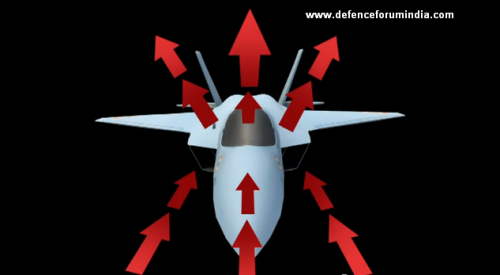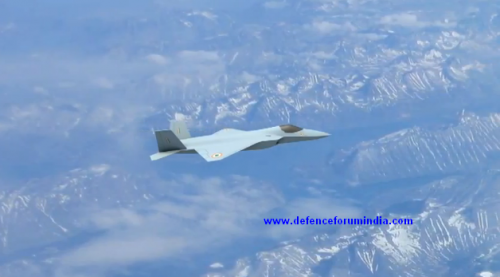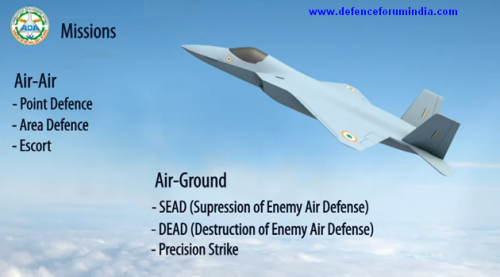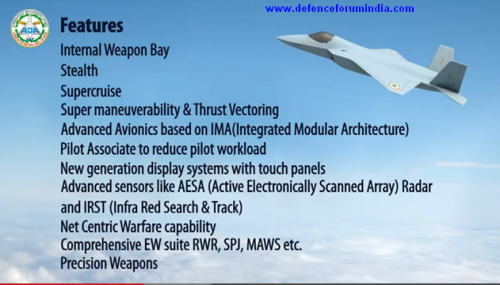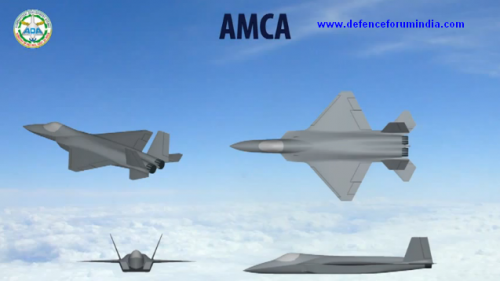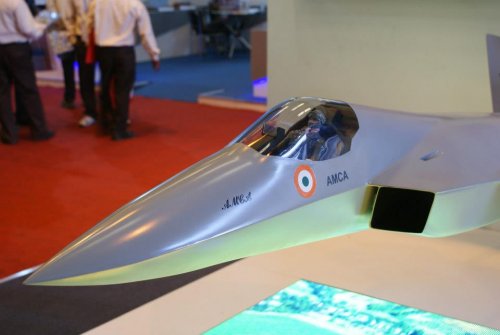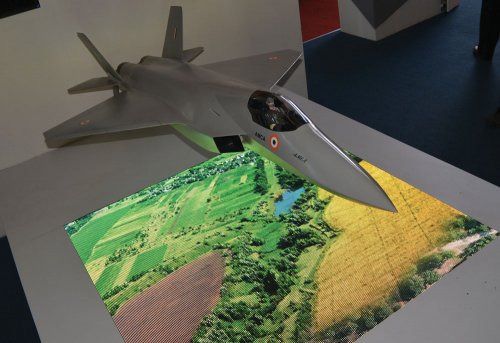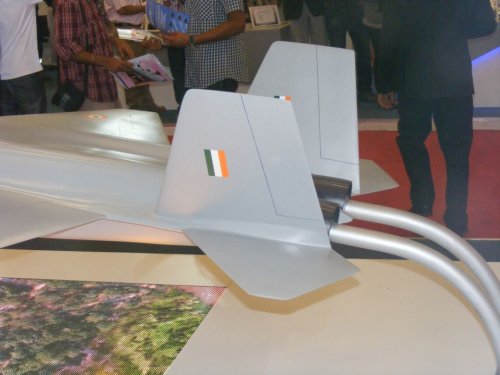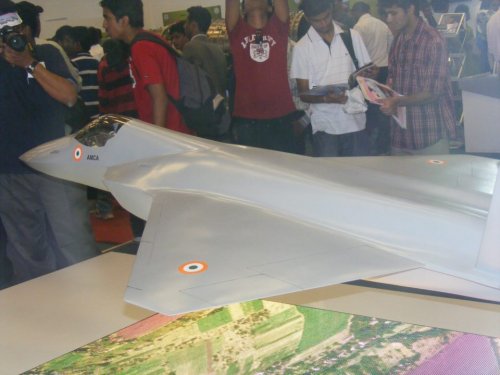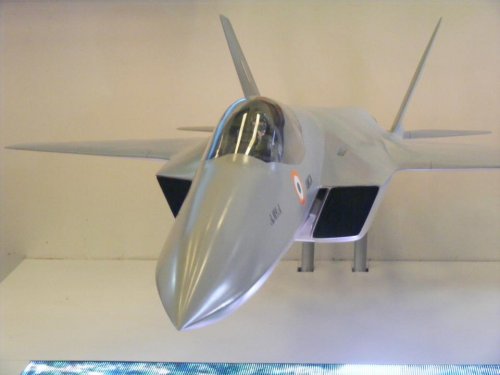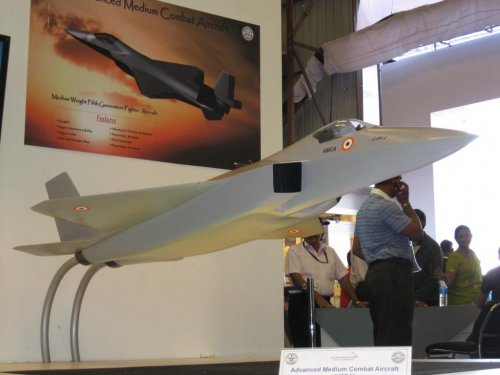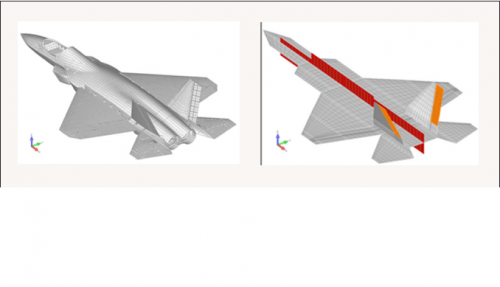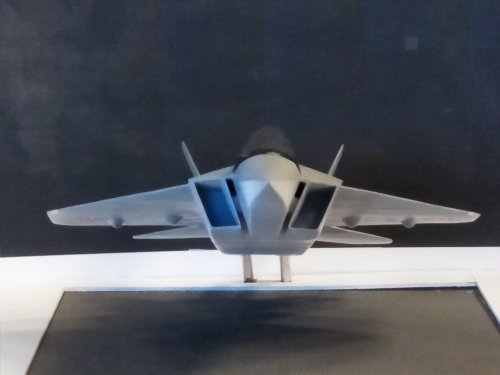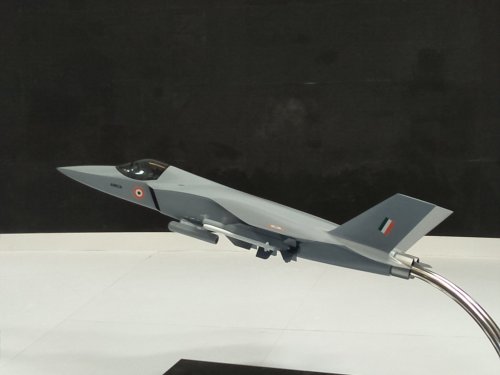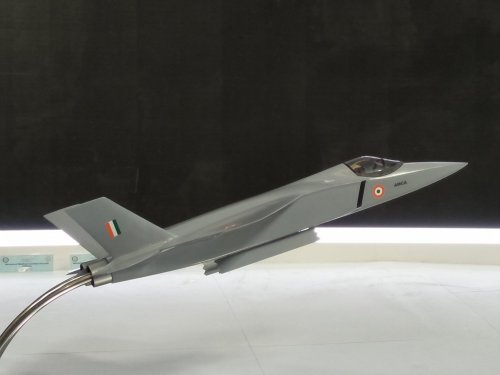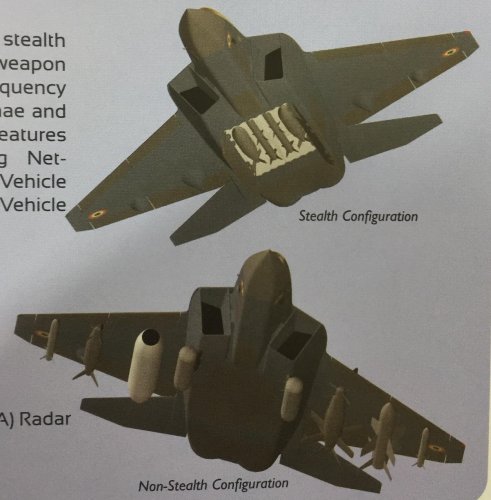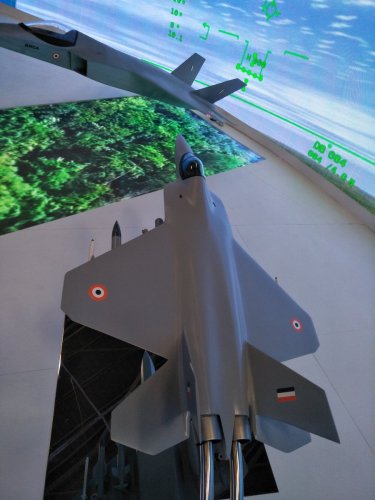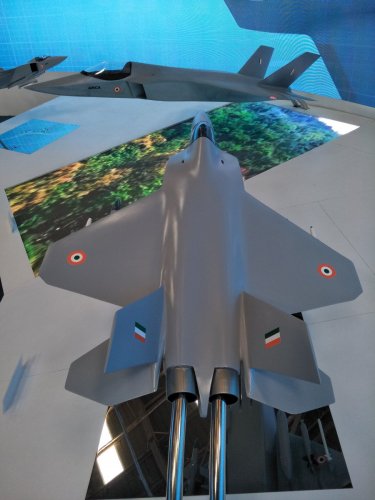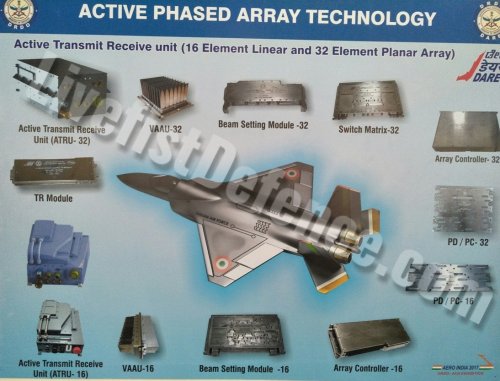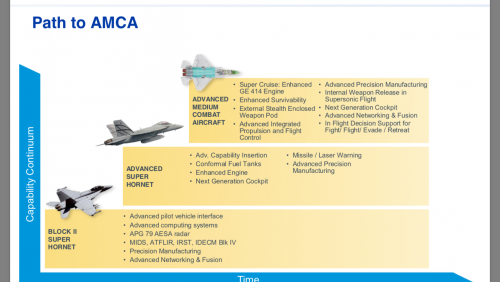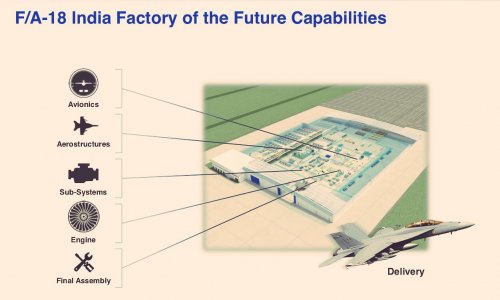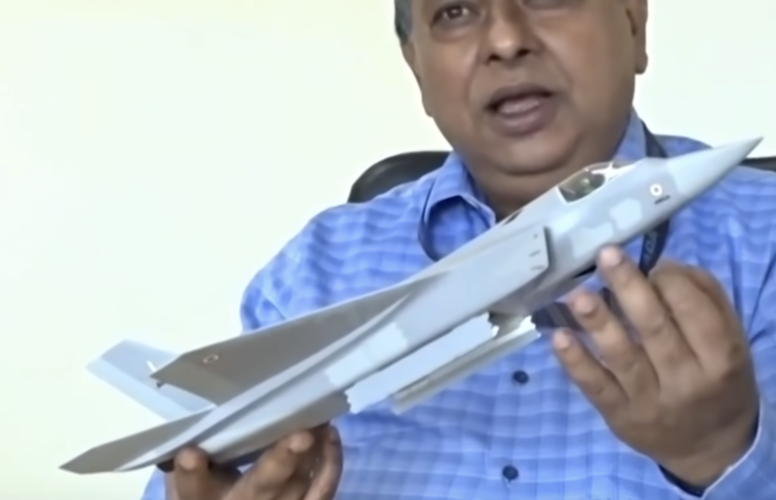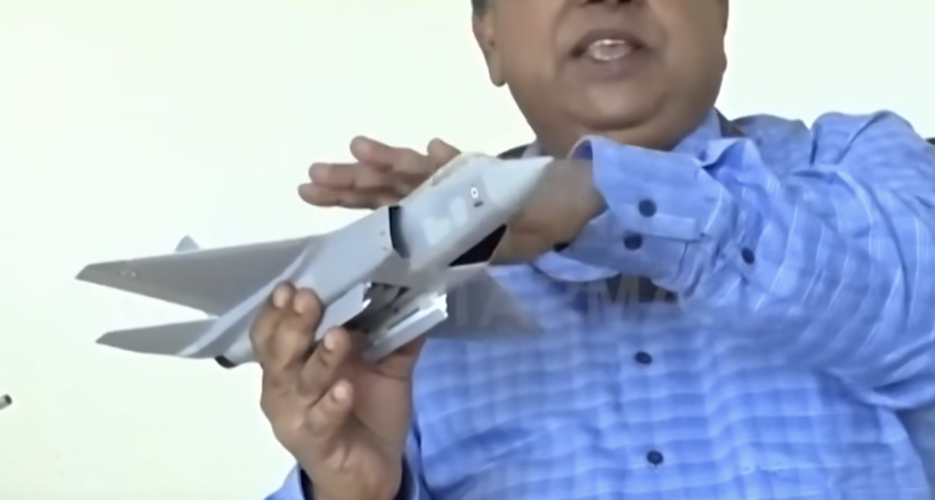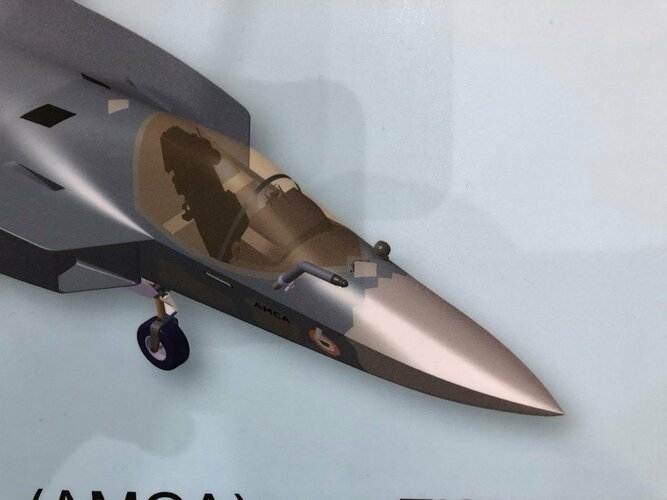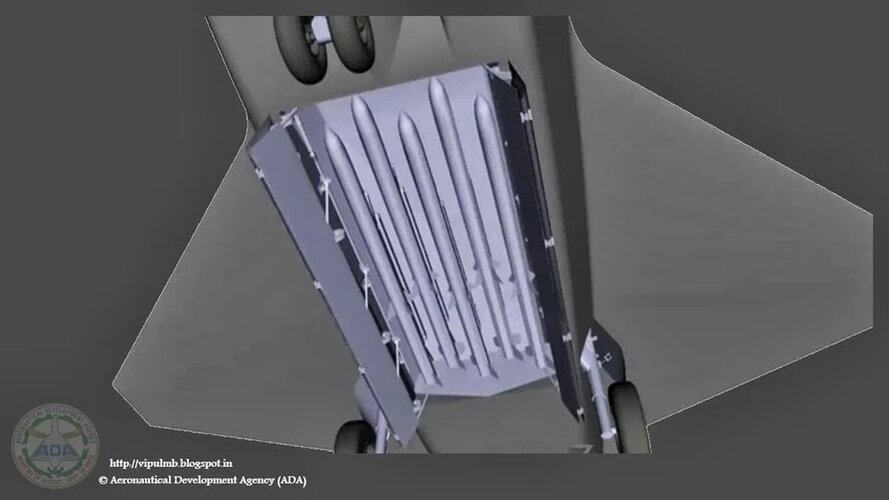You are using an out of date browser. It may not display this or other websites correctly.
You should upgrade or use an alternative browser.
You should upgrade or use an alternative browser.
India's 5th generation fighter programme - from MCA to AMCA
lancer21 said:With all that iranian mock-up frenzy, a rather more interesting piece of information has been omitted these days , here's the apparently final , or almost final configuration of AMCA.
Seems like a design with some unique elements to it, always positive. Got inspired to do a round of Googling for recent info, the big news seems to be the upcoming unveiling of a new scale model (1/8) at Aero India. They do not seem to be rushing the project (first flight predicted towards the latter part of the decade, quite reasonable) nor seeking an inordinate amount of publicity (despite some lofty claims on blogs I can't verify).
Certainly deserving of attention (in-Qaher-ent one ring circuses aside) along with at least Korean/Indonesian, Japanese and Turkish projects. This certainly points to an environment where F-35 is far from the only game in town, even omitting Chinese and Russian efforts. I also wonder whether Europeans have resigned to a UAV approach only or whether the French, for example, might still work towards new manned fighters.
2IDSGT
Ah tale yew wut!
- Joined
- 27 November 2012
- Messages
- 365
- Reaction score
- 14
100 people surveyed. Number one answer's on the board... Name the engine it'll use! ...for this or any of the Turkish/Japanese/Korean Power-Point fighters.lancer21 said:With all that iranian mock-up frenzy, a rather more interesting piece of information has been omitted these days , here's the apparently final , or almost final configuration of AMCA.
The big gap on the model between the wing and stabilizers seems wrong. The wings seems unusally far forward in relation to the engine and empannage. This has to lead to some center of gravity vs center of lift issues. Perhaps the model is not a accurate representation of the final configuration.
- Joined
- 9 October 2009
- Messages
- 21,973
- Reaction score
- 13,628
Probably a long shot, but, could it be space provision for equipment and such needed for a future VSTOL or STOVL version?
- Joined
- 1 April 2006
- Messages
- 11,394
- Reaction score
- 10,292
XF5-1 for ATD-X. I believe that yes, they can.2IDSGT said:for this or any of the Turkish/Japanese/Korean Power-Point fighters.
- Joined
- 2 August 2006
- Messages
- 3,255
- Reaction score
- 1,527
The fuselage doesn't seem too long to me. You want a long fuselage for supersonic flight. However, I think many people "think" it has a long fuselage due to the placement of the vertical tails. They look like they are placed further back than they are on most contemporary fighters.
Maybe they did that for high alpha reasons, but most fighters of similar configuration have the vertical tails located at the gap between the wing and the horizontal tails. Which should work out well for area ruling, but as I noted above, maybe such a placement had an adverse affect on the them at high alpha, like the legacy Hornets. So they moved them back deciding the wave drag penalty wasn't as great as the structural weight penalty required if they were further forward? That's just my best guess atm.
Maybe they did that for high alpha reasons, but most fighters of similar configuration have the vertical tails located at the gap between the wing and the horizontal tails. Which should work out well for area ruling, but as I noted above, maybe such a placement had an adverse affect on the them at high alpha, like the legacy Hornets. So they moved them back deciding the wave drag penalty wasn't as great as the structural weight penalty required if they were further forward? That's just my best guess atm.
2IDSGT said:100 people surveyed. Number one answer's on the board... Name the engine it'll use! ...for this or any of the Turkish/Japanese/Korean Power-Point fighters.
My incomplete understanding:
The Turks, last reported as looking into Italians and Brazilians (Embraer) as partners (the Korean angle having fallen through); don't know what kind of engines they could source. T/FX is complementary to F-35 and not a direct competitor so US engines might not be out of the question. If someone can provide more backround to this, I'd appreciate it.
Japanese, as discussed.
Koreans, use GE F404 for the T-50 which I gather is not an ideal option. Might get something out of technology transfer programs by going with the Silent Eagle or Eurofighter: Don't know if EJ200 is an exportable item. Can't remember reading it anywhere that Koreans might design or manufacture their own engines, but then again the South sometimes echoes their estranged northern brothers' and sisters' penchant for self-sufficiency in some peculiar ways.
Indians, have their toe in the water (or air) with Kaveri already. Admittedly not a great success by any standard but they're in the enviable position of being able to acquire technology from almost anyone save for the Chinese. Again, don't know if Snecma M88 is an exportable item. Anyway, AMCA's schedule allows for quite a lot for gathering experience with their own designs - especially as they soon have a reasonable fallback position in HAL FGFA/ Rafale and the Chinese seem more intent on rattling their sabers in the Pacific anyway.
Sundog said:The fuselage doesn't seem too long to me. You want a long fuselage for supersonic flight. However, I think many people "think" it has a long fuselage due to the placement of the vertical tails. They look like they are placed further back than they are on most contemporary fighters.
Maybe they did that for high alpha reasons, but most fighters of similar configuration have the vertical tails located at the gap between the wing and the horizontal tails. Which should work out well for area ruling, but as I noted above, maybe such a placement had an adverse affect on the them at high alpha, like the legacy Hornets. So they moved them back deciding the wave drag penalty wasn't as great as the structural weight penalty required if they were further forward? That's just my best guess atm.
The front end has YF-23 echoes in it (to me), but the tail is obviously entirely different - wonder if the combined tail area might still be in the same ballpark in both aircraft? Not only is AMCA long, it's also narrow but so is J-20, more of a sequential than s parallel approach to packaging. I looked up the Hornet problem, buffeting due to LEX vortices if I understood correctly: I can't see AMCA having LEX as such though the top of the intake forms a similar shape? In side view the vertical tails' leading edges seem remarkably upright. Something to be gleaned from that?
- Joined
- 9 October 2009
- Messages
- 21,973
- Reaction score
- 13,628
flateric said:Something like to Pluto and beyond.
;D
UpForce is right in pointing out the oddity of AMCA's vertical tails: not only are they almost upright, but they are also huge and almost rectangular in shape- hardly enhances stealth. On the whole,unlike the front which brings to mind Shin-shin with the cockpit canopy betraying T-50 influence, the entire aft section looks awkward; if something looks bad, it flies bad.
Sundog said:The fuselage doesn't seem too long to me. You want a long fuselage for supersonic flight. However, I think many people "think" it has a long fuselage due to the placement of the vertical tails.
It's not that the fuselage seems too long. It's the wings seems to be too far forward. It looks to me like the engine, if it is roughly proportioned like a F414, would be located almost entirely behind the trailing edge of the wing. That just seems implausible to me, unless this plane has an highly unusual design which derives a large amount of lift from the horizontal stabilizers, like a lifting canard in reverse.
UpForce said:In side view the vertical tails' leading edges seem remarkably upright. Something to be gleaned from that?
Japanese Shin Shen stealthy demonstrator seems to have fairly unright vertical stabilizer leading edge as well.
- Joined
- 27 December 2005
- Messages
- 17,748
- Reaction score
- 26,417
Apparently, screenshots from the video (via defenceforumindia.com)
Attachments
- Joined
- 27 December 2005
- Messages
- 17,748
- Reaction score
- 26,417
Changes to the AMCA planform seem to indicate greater emphasis on all-aspect stealth.
Model of HAL AMCA on display at Aero India 2013.
Source:
http://www.militaryphotos.net/forums/showthread.php?89961-Indian-Armed-Forces/page521
http://www.ainonline.com/aviation-news/paris-air-show/2013-06-13/indian-home-grown-amca-alternative-fgfa
http://defenceforumindia.com/forum/indian-air-force/38586-aero-india-2013-a-13.html
Source:
http://www.militaryphotos.net/forums/showthread.php?89961-Indian-Armed-Forces/page521
http://www.ainonline.com/aviation-news/paris-air-show/2013-06-13/indian-home-grown-amca-alternative-fgfa
http://defenceforumindia.com/forum/indian-air-force/38586-aero-india-2013-a-13.html
Attachments
FighterJock
ACCESS: Above Top Secret
- Joined
- 29 October 2007
- Messages
- 5,607
- Reaction score
- 5,936
Would the purchase of the MCA affect the final total purchace of the FGFA? Or would they order a split 50/50 buy of both fighters?
- Joined
- 2 August 2006
- Messages
- 3,255
- Reaction score
- 1,527
I found this interesting and thought it might interest others here as well;
That's from Flight Global
The biggest challenge involves the development of Radar Absorbent Material (RAM).
He alluded to New Delhi’s challenges in the area of radar cross section (RCS) reduction in comments about the collapse of the 2012 deal to buy 126 Dassault Rafale fighters.
There were several issues that caused the Rafale deal to collapse, he says, but he specifically pointed to France’s unwillingness to part with a proprietary RAM that is applied to the Rafale’s canopy. Had the deal moved forward, Rafales completed in India would have been sent to France to receive the coating.
That's from Flight Global
New HAL AMCA model on display at AeroIndia 2017 posted by LiveFist on Twitter.
Source:
https://twitter.com/livefist/status/831335665711325184/photo/1
Source:
https://twitter.com/livefist/status/831335665711325184/photo/1
Attachments
"EXCLUSIVE: India’s 5th Gen AMCA Targets 2030"
Shiv Aroor Feb 16 2017 10 30 am
Source:
http://www.livefistdefence.com/2017/02/exclusive-indias-5th-gen-amca-targets-2030.html
Shiv Aroor Feb 16 2017 10 30 am
Source:
http://www.livefistdefence.com/2017/02/exclusive-indias-5th-gen-amca-targets-2030.html
As your correspondent reports, the first 1:1 full scale model of India’s fifth generation concept Advanced Medium Combat Aircraft (AMCA) is being built in Bengaluru. Later this year, the model will undergo a series of rigorous tests at an RCS facility in Hyderabad, where the programme team will have its fest chance at seeing how the shape they’ve chosen for the jet deals with radiation. The exercise will be historic. Because it will be the first time India will be specifically testing a stealth airframe.
Cmde C.D. Balaji, chief at the Aeronautical Development Agency (ADA) met with Livefist at the Aero India show for a chat on the programme. ‘This will be our first big learning process. We need to be sure about the conformal antennas and shapes before we finalise the airframe,’ he says. Another very crucial application the team plans to bring into play is computational electromagnetics, to simulate in parallel how the concept jet deals with radar and other assaults built to beat stealth.
‘About 60-70% of the stealth we intend will come from the aircraft’s shape. The rest we are discovering as we develop the aircraft. Nothing like this has ever been attempted before,’ Balaji says. An AMCA model debuted at Aero India 2009, the first time anyone got a sense of what the ADA was looking to build.
The team at ADA expects full-scale engineering development till the prototype stage to take at least a decade. Livefist also learnt that the team now has a specific timeframe for a first flight: 2030, with low-rate production to begin in 2035. ‘If you consider that the LCA Mk.1 will be built till 2024 and the LCA Mk.2, when ordered, should be built between 2030-35, then 2035 is good target for production of the AMCA,’ Balaji says.
The AMCA project could find additional backing and strength owing to persistent problems India faces from Russia over the T-50 FGFA programme. On Tuesday, Defence Minister Parrikar even admitted that there were problems that needed sorting. Earlier this year, the government took the surprising step of setting up a committee to go over the FGFA programme and actually see if India benefits at all. Negotiations have meandered over work share and how qualitatively India will even contribute to the programme other than be its largest operator. Sources on the AMCA team wouldn’t commit, but wouldn’t deny that trouble with the FGFA programme only placed greater (and welcome) pressure on the indigenous effort to deliver on time and cost — and capability.
Attachments
From LiveFist:
Source:
https://twitter.com/livefist/status/831751225276239872
A lot of you asked, so here goes: Top shot of the new AMCA models at #AeroIndia2017.
Source:
https://twitter.com/livefist/status/831751225276239872
Attachments
FighterJock
ACCESS: Above Top Secret
- Joined
- 29 October 2007
- Messages
- 5,607
- Reaction score
- 5,936
Triton said:From LiveFist:
A lot of you asked, so here goes: Top shot of the new AMCA models at #AeroIndia2017.
Source:
https://twitter.com/livefist/status/831751225276239872
Great looking photos Triton. Thanks for sharing. B)
"Probably The Most Significant Take-Away From Aero India 2017"
Shiv Aroor Feb 20 2017 12 41 pm
Source:
http://www.livefistdefence.com/2017/02/probably-the-most-significant-take-away-from-aero-india-2017.html
Shiv Aroor Feb 20 2017 12 41 pm
Source:
http://www.livefistdefence.com/2017/02/probably-the-most-significant-take-away-from-aero-india-2017.html
Take a moment to look at the image above. Savour it. This was one among hundreds of posters plastered everywhere at the recently concluded Aero India show. And yet, in it lies what is possibly the most meaningful indicators from India’s indigenous efforts in military aviation. We’ll get to the specifics in a bit. First, some background.
A few days ago, Livefist’s big update on India’s fifth generation AMCA programme brought the spotlight back on the concept fighter, amidst reports of trouble in Indo-Russian talks to resolve the stalemate plaguing the proposed joint Fifth Generation Fighter Aircraft (FGFA). On the latter front, things have reached a stage where some abrupt and spectacular suggestions have been made by Rostec, the Russian state holding company, including that the FGFA has nothing to do with the under-flight-test T-50/PAK FA (will be a totally separate fighter), and that Russia will be partnering with India on the AMCA. To be sure, there are several tech partnership suitors for the AMCA, and Russia happens for the moment to be only one of them.
Livefist’s update on the AMCA drew a huge amount of interest (and readership), unsurprising given it is one of two most ambitious active aviation efforts in the country — the other being the related Ghatak stealth UCAV. But while we were looking through the huge number of images we captured at the just concluded Aero India 2017 show, we chanced upon the above slide that we found tucked away in a corner of the small Defence Avionice Research Establishment (DARE) stall in the DRDO pavilion.
While we’ve reported extensively on the AMCA’s intended stealth characteristics, including serpentine intakes and internal weapons bays, the slide you see here is, in Livefist’s view, the most significant and revealing set of details on the deep research being done in what is by far the most challenging part of the AMCA’s design: active phased array technology. This comprises the spread of separate sensor elements embedded across the AMCA’s airframe in a way that consolidates overall stealth and lowers all aspects of the aircraft’s final signature, while making use of that very spread to provide a heightened degree of sensor coverage and domain awareness to the pilot. (Think of the spread like a dashboard camera that’s actually a network of cameras situated all around the car, providing the driver with a wide sweep view of what’s happening around the vehicle).
Antenna elements as part of the phased array spread will come up for their first torture test with the full scale AMCA mock-up soon in Hyderabad. And getting it right is non-negotiable, especially since this is technology no company or country will conceivably share.
The 16 element linear and 32 element planar array will either segue smoothly into the functionality of stealth or stick out sorely and make the AMCA significantly more visible across electromagnetic spectra. In other words, it isn’t just how well these little elements work separately, but how they work together — and above all, how well they are housed in the body of the aircraft so they don’t interfere with stealth.
‘Make of break technology’ in the words of a DARE scientist who spoke on condition of anonymity to Livefist. Antenna architecture, overall computational electrodynamics and the true integration of these elements with an airframe design that’s still in flux means there’s huge pressure to get it right. Indeed, this is research that could have spin-offs for the LCA Mk.2 programme as well.
While the AMCA is still in a design stage and awaiting sanction as a full-blown project, the slide you see here is affirmation that the most significant elements that will potentially make the AMCA a true fifth generation machine are deep in the works. This is research that will imbue the performance of India’s Ghatak UCAV too, considering the large amount of basic technological R&D feeding jointly into both programmes (as Livefist reported to you earlier, the AMCA and Ghatak are actually a joint lead-in project).
Tech partnerships on the AMCA will likely involve offsets-driven sensor packages and broad consultancies in the post-design phase, including flight test and airborne empirical studies new to India since this will be the country’s first stealth aircraft built at home. What those partnerships won’t include are the driving forces that compel the very stealth that the AMCA hopes to sport. The road ahead is a very long, hard one. But the slide above also establishes that there’s clarity of approach in at least the most crucial aspects of India’s most ambitious military aviation venture.
Attachments
"Boeing Unveils An AMCA ‘Sweetener’"
Shiv Aroor Nov 16 2016 10 50 pm
Source:
http://www.livefistdefence.com/2016/11/boeing-unveils-an-amca-sweetener.html
Shiv Aroor Nov 16 2016 10 50 pm
Source:
http://www.livefistdefence.com/2016/11/boeing-unveils-an-amca-sweetener.html
As Boeing Defense revives its campaign for the F/A-18 Super Hornet in India, a slide in its presentation today on the pitch stands out significant and adds telling detail to an aspect of the effort that has remained relatively unknown — how India’s proposed Make In India Fighter programme ties in with the country’s concept fifth generation development AMCA platform. We now know that Boeing has a very specific plan, with three major thrusts:
First, as the slide most visibly suggests, Boeing proposes that the manufacturing facility and supply eco-system that it builds up for the F/A-18 in India in the event it is chosen, could be used to produce the AMCA. The existing facility could be leveraged, precluding the need for a greenfield setup elsewhere.
img_7115
Second, also mentioned specifically in the slide is the GE 414 enhanced engine pitch. Significant. Boeing here is proposing engine commonality from the get-go to support the prospective selection of the Super Hornet platform. Both Boeing and GE are in ‘multiple stakeholder discussions’ with the DRDO, Indian Air Force (and, presumably the MoD) on this aspect, said Boeing India President Pratyush Kumar during a presentation by Dan Gillian, Boeing’s VP on the F/A-18 programme headquartered at St Louis (Livefist is in the United States at the invitation of Boeing Defense). The enhanced GE 414 would be a feature on the Advanced Super Hornet proposed as part of the Make In India pitch. How this ties in with India’s own engine development efforts and opportunities remains unclear. The indigenisation thrust need to ensure the Kaveri effort hasn’t gone to waste — the AMCA could potentially be India’s last indigenous manned fighter project for the next three-four decades.
Finally, there is the suggestion that Boeing could be available to help along the AMCA programme directly as a partner or consultant in such a way that it makes the Block 2 Super Hornet -> Advanced Super Hornet -> AMCA flow more seamlessly from a development-to-manufacturing perspective.
This is an aggressive pitch that amplifies the sort of deep dive that competitors for the MIIF deal could be willing to put on the table. It also has several implications on the dynamics of partnerships and indigenous development from the ground up for a programme that will be infinitely more complex than not just a flyaway deal — but also the aborted M-MRCA.
Attachments
- Joined
- 29 November 2010
- Messages
- 1,775
- Reaction score
- 3,479
a recent interview with a current model of the AMCA, you can see its bays more clearly here
View: https://www.youtube.com/watch?v=QSul7iEoy_c
Attachments
FighterJock
ACCESS: Above Top Secret
- Joined
- 29 October 2007
- Messages
- 5,607
- Reaction score
- 5,936
a recent interview with a current model of the AMCA, you can see its bays more clearly here
View: https://www.youtube.com/watch?v=QSul7iEoy_c
One question about the AMCA, will it come with an Infrared Search and Track? When I looked at the photos and the video it does not look like there is going to be one, or will it be added to the production aircraft.
- Joined
- 29 November 2010
- Messages
- 1,775
- Reaction score
- 3,479
^ i havent seen one either
on related news (should this be a new thread?)
a model of an Indian loyal wing man

on related news (should this be a new thread?)
a model of an Indian loyal wing man
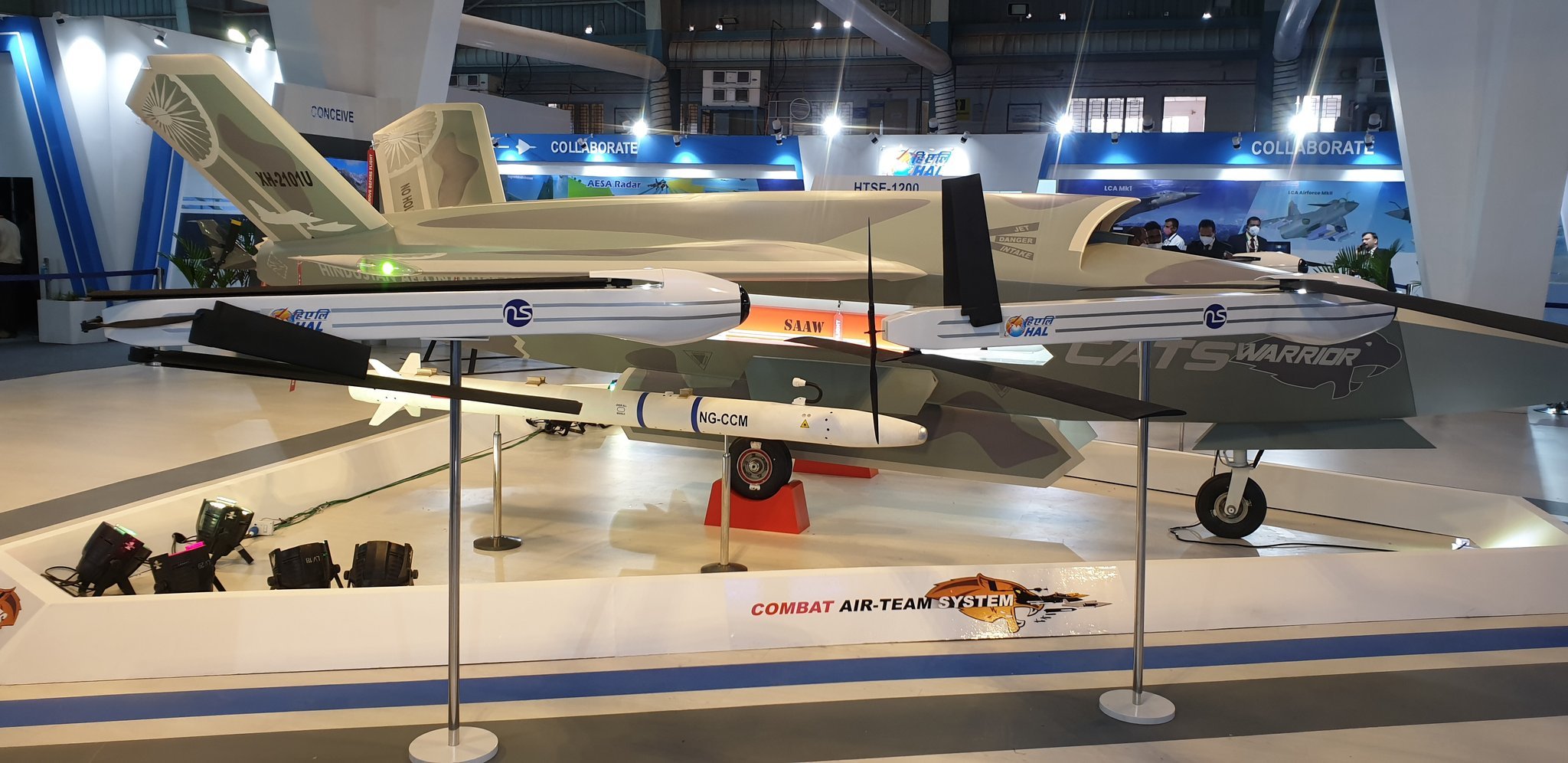
- Joined
- 29 November 2010
- Messages
- 1,775
- Reaction score
- 3,479
^ nice catch! didnt notice
back to AMCA, supposedly this is the final config
here is the pics from AI 2021 via https://twitter.com/ReviewVayu

nothing about IRST




back to AMCA, supposedly this is the final config
here is the pics from AI 2021 via https://twitter.com/ReviewVayu

nothing about IRST
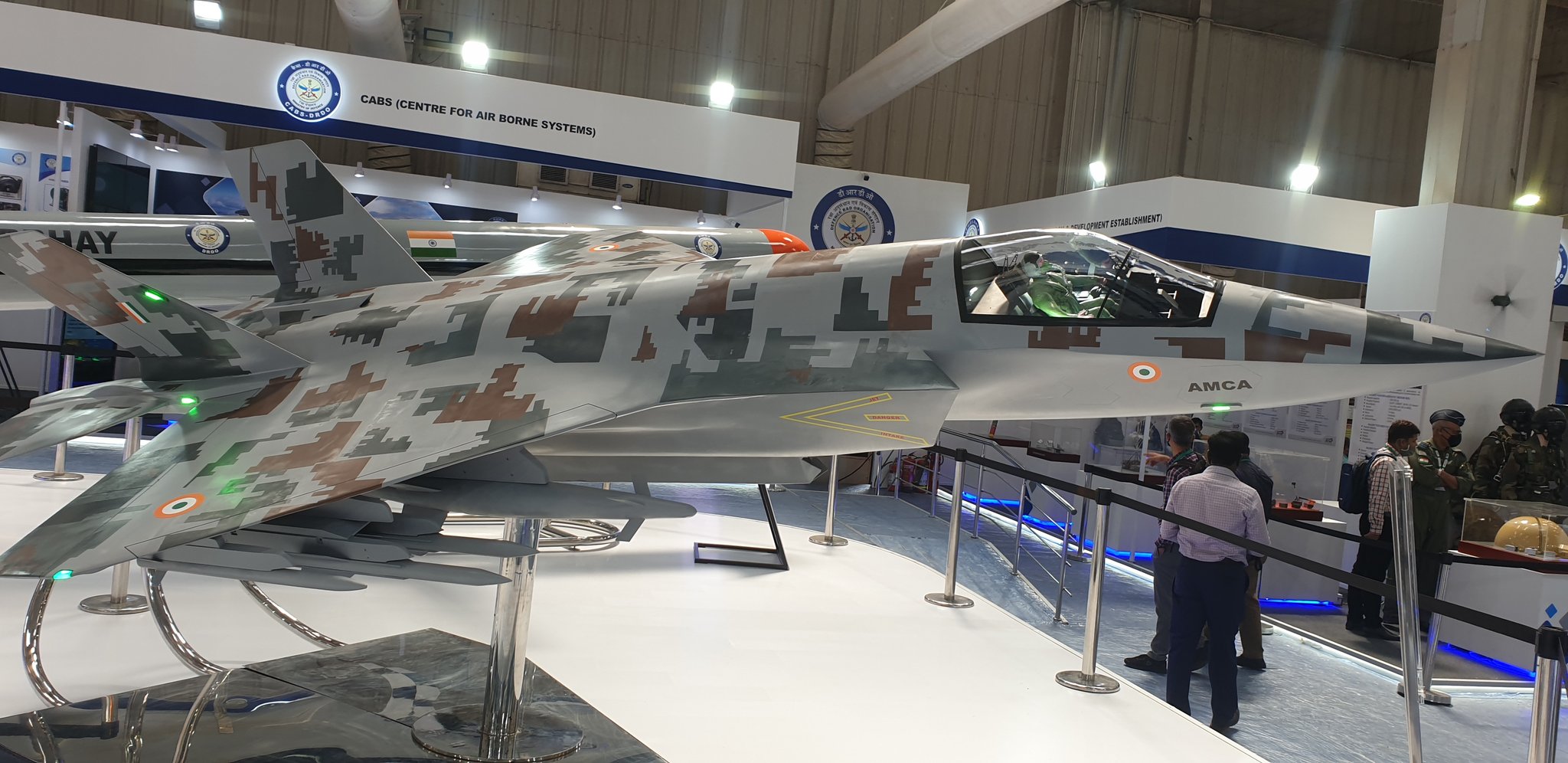
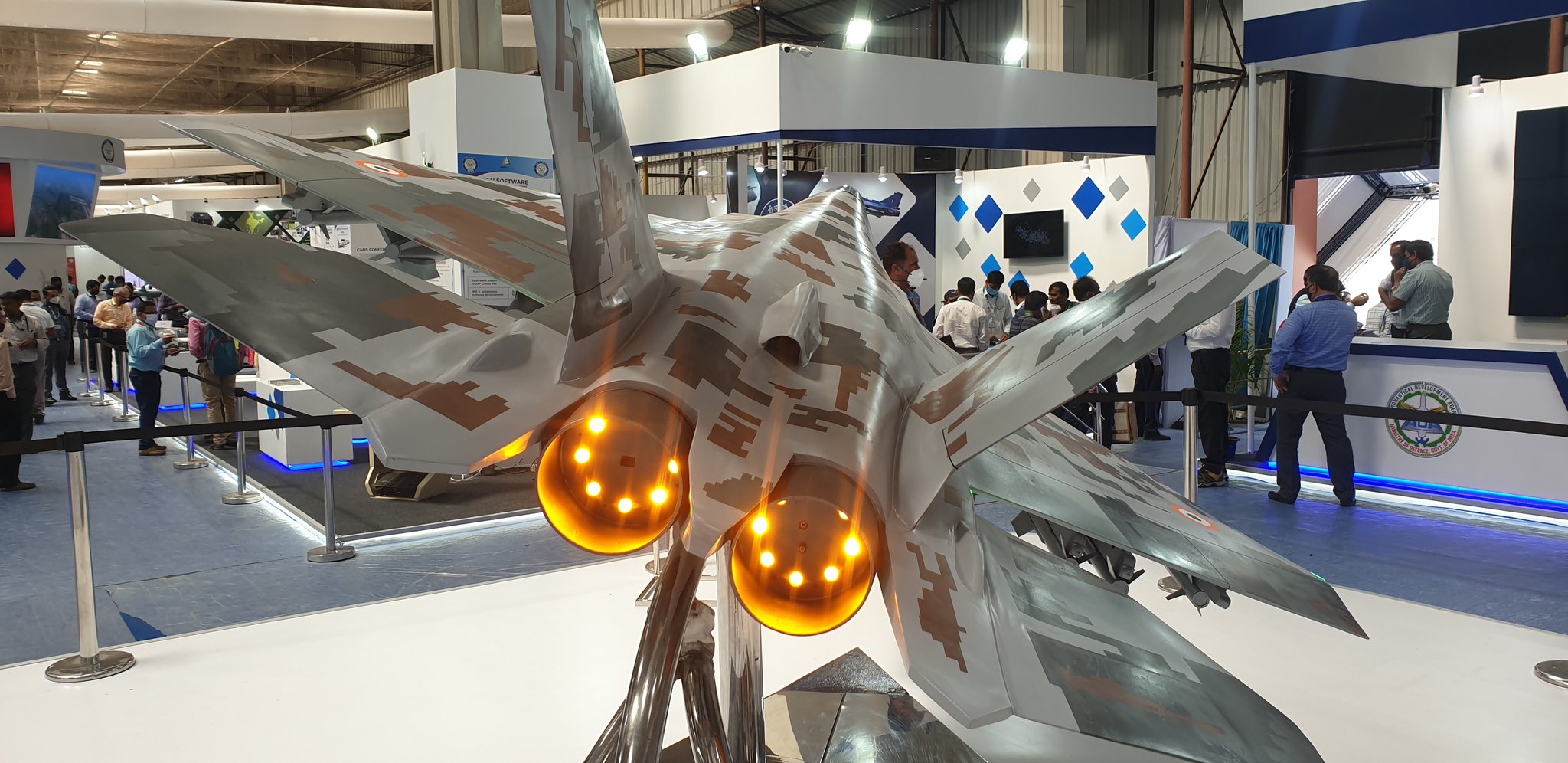
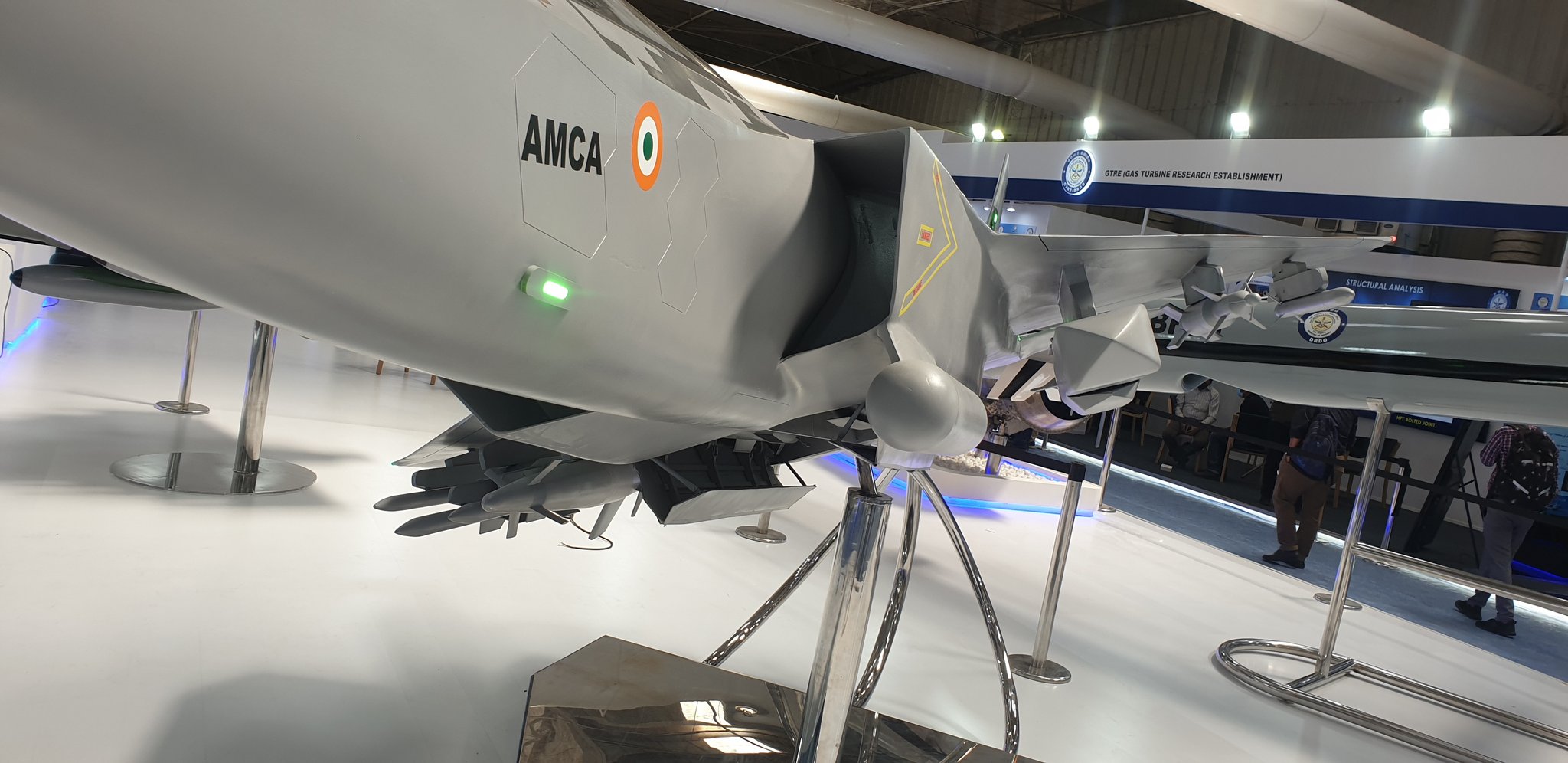
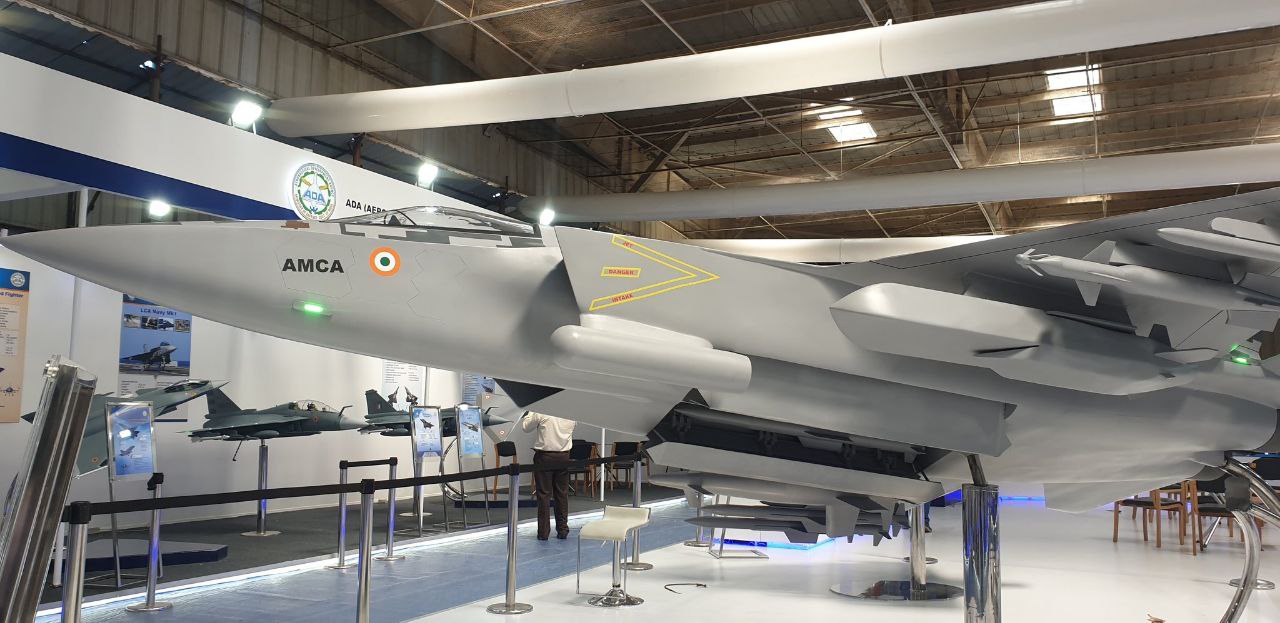
Last edited by a moderator:
FighterJock
ACCESS: Above Top Secret
- Joined
- 29 October 2007
- Messages
- 5,607
- Reaction score
- 5,936
Is that a Storm Shadow that I can see in the bottom photo helmutkohl? It is also strange to see the AMCA with an external targeting pod as well.
Last edited by a moderator:
More like KAI approach. Interesting to see how 5th gen fleet would be segregated in the future b/w full multirole and configurable airframe. (meaning that F-35 sales will outpace without reasonable doubts the Phantom ones).
To me, it's a beautiful airframe, raced and I very much like the Sukhoi inspiration.
So now, what is that Su-57's auxiliary inlet clone ontop of the engine pack?



To me, it's a beautiful airframe, raced and I very much like the Sukhoi inspiration.
So now, what is that Su-57's auxiliary inlet clone ontop of the engine pack?

Last edited:
FighterJock
ACCESS: Above Top Secret
- Joined
- 29 October 2007
- Messages
- 5,607
- Reaction score
- 5,936
I too like the looks of the AMCA TomcatVIP, I hope that in the future once it enters Indian Air Force service, the powers that be allow it to be exported. I would think that it would be a shame if it was not allowed, a bit like what I thought when the US stopped the export of the F-22.
- Joined
- 11 February 2010
- Messages
- 1,650
- Reaction score
- 2,702
Browsing the earlier post. Supercruise and TVC. and all in "medium" sized airframe. Russian RD-33MK, GE-F414 and M88 are relatively comparable in terms of dry thrust. But for TVC.. seems Russian engine have the advantage of real flight experience with KLIVT nozzle.
FighterJock
ACCESS: Above Top Secret
- Joined
- 29 October 2007
- Messages
- 5,607
- Reaction score
- 5,936
Retractable IRST & optional 5 BVR internal bay (both in previous iteration).
So it does come with an IRST after all and it is retractable, that is different.
Cannonfodder43
ACCESS: Confidential
- Joined
- 8 December 2019
- Messages
- 115
- Reaction score
- 303
Little confused that they would prefer to make the IRST retractable.
Surely a faceted housing or the Russian rotating RAM covered rear would be a less complex option.
Surely a faceted housing or the Russian rotating RAM covered rear would be a less complex option.


